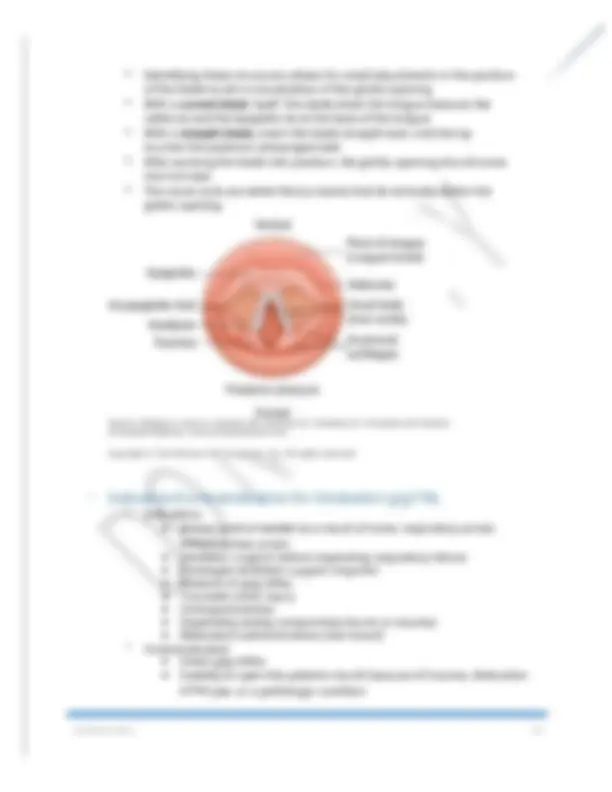Download FISDAP Final Paramedic Study Guide Latest Update 2025. and more Exams Nursing in PDF only on Docsity!
FISDAP Final Paramedic Study Guide Latest Update 2025.
Ems Operations - Page 1 OB/Gynecology - Page 11 Pediatrics - Page 20 Airway - Page 30 Medical Emergencies - Page 39 Trauma - Page Cardiology - Page - Page 54
EMS OPERATIONS
- Airbags Safety During Extrication (2228)
- Un-deployed airbags may deploy during extrication and cause harm to the patients and rescuers.
- Look for airbag badging or labeling system
- A vehicles airbags system comes equipped with an energy capacitor that can store power for up to 30 mins in some models
- Remove key from ignition 4. Criteria for Transferring Care of Patient (154)
- In your documentation of care, it is important that you were able to show in whose care you left the patient with, otherwise you could face allegations of abandonment. some agencies have begun to require physician or nurse signatures to verify that the patient was left with a medical professional of a higher level of training. Another situation that may require you to document a transfer of care is when you hand over your patient to another agency such as a paramedic transport crew or an air medical team. 5. Decontamination of Airway Equipment
- Sanitize and disinfect everything after a call
- Any piece of equipment that is intended for single use should be discarded in an appropriate hazardous materials bag. For any reusable piece of equipment that has had direct contact with the patient or patients bodily fluids, use a commercial disinfecting agent for decontamination. Bleach diluted in water (1:10) can also be used as disinfecting agent.
6. Documenting Medication Administration (471)
- Documentation is everything, if you did not document it, you didn’t do it. Always document your actions and the patients response on the on the patient care report after administering a medication. This includes...
- Name
- Dose
- Time
- Route
- Persons^ name who administered it
- Patients response to the medication,^ whether^ positive or^ negative 7. Indications for N95 Mask
- 95 (Heppa) Mask on you, surgical or normal mask on patient 8. Indications for Rapid Extrication (1677-1699) (2226)
known as “In loco parentis”. This term literally means “In place of the parent”. This principle may apply in school, day care, or summer camp situations if a parent is unavailable. The school administrator or day care director may make treatment and transportation decisions on behalf of the minor. A particularly difficult circumstance can arise if a parent or legal guardian refuses to grant consent to treat a minor who clearly requires lifesaving or limb-saving treatment. Although adults clearly have the right to refuse treatment for themselves, state laws generally do not permit a parent or guardian to deny treatment to a minor child. In fact, the failure of a parent to allow such treatment may constitute neglect. When confronted with such a circumstance, the paramedic should notify law enforcement and medical control. State law may permit the state to
assume custody of the child for purpose of ensuring that necessary emergency treatment be provided. Emancipated Minors - are under legal age in a given state but can be treated as legal adults because certain circumstances. By court order. Marriage, pregnancy, or active military service. They can accept or deny care.
12. Operations within a HazMat Scene Responding to Hazmat incidents
· Look^ for^ warning signs such as patient^ S/S,^ placards,^ labels,^ etc.
· Placards or labels may be found on building, trucks/railway cars,
drums/storage (^) vessels
· Intentional ingestion of chemicals and activities occurring at illicit labs or
potential (^) terrorist activities may have no obvious signs
· Some chemicals are odorized (propane, methane) where other
dangerous (^) substances are odorless (carbon monoxide)
· If you approach a scene where more than one person has collapsed
due to (^) respiratory distress, suspect the presence had a hazardous material
· When^ arriving,^ you should stop at^ a safe distance,^ uphill and^ upwind from^ the
scene
· Items^ to report^ include:
o (^) Exact location o (^) Atmosphereic conditions o (^) Size/shape of containers o (^) Chemical ID number or symbols o (^) # of victims with S/S o (^) Type and number of additional resources
- Stress Management (42-43)
- Fight or flight mode S/S - heart palpitations, rapid breathing, chest tightness, sweating, rapid breathing, unnecessary shouting.
- Control breathing
- Progressive Relaxation - tighten/relax muscle groups to initiate muscle relaxation throughout the body. Stupid.
patient is unable to express his or her wishes. Living wills, DNR’s, and organ donation orders are all advance directives. DNR’s can also be called Resuscitation Directive Living Wills and Health Care Power of Attorney are types of advance directives in which a patient can express wishes regarding end-of-life medical care. These directives are sometimes called health care “durable” power of attorneys because they remain in effect once a patient loses “decision making capacity”. The person who carries the Health Care Power of Attorney is often called the “Surrogate Decision Maker”. They are legally obligated to make decisions as the patient would want, and has presumably discussed these decisions with the patient. It is important to keep in mind that the “Surrogate Decision Maker” has no authority until the patient becomes incapable of making decisions. If the “Surrogate Decision Maker” is attempting to make decisions that conflict with a competent patients decisions, the patients decisions are always the ones to be followed.
20. Treating a Violent Patient (99/100)
- May restrain a violent patient to protect you/crew and as well as the patient
- Under the law, you are only able to use force if the patient attacks you. You may defend yourself.
- Contact Law Enforcement if patient becomes uncooperative and or has weapons.
- Violence can be the result of hypoxia, hypoglycemia, mental illness, brain injury, drug abuse/ OD, or alcohol use, and psych problems.
- Protocol dependent - however, some agencies let EMS personal use “Chemical Restraints” such a benzodiazepines or antipsychotics to calm patients who are violent and need transportation to hospital.
- If scene is not safe - contact Law enforcement and go back to ambulance like a lil bitch boy you are
- Bullet proof vests?
- Always be aware of your surrounding
- Soft restraints while transporting if needed
OB/GYNECOLOGY
1. Complications Associated with Pregnancy Induced Hypotension (1931)
- When a Pregnant females uterus compresses the Inferior Vena Cava, venous blood return to the heart is diminished or occluded.
- Occurs when the women is Supine, or sometimes when she is sitting
- Usually in the 3rd Trimester
- Can lead to fetal distress
- Generally takes 3-7 minutes of Compression before S/S occur
- Early S/S - Nausea, Dizziness, Tachycardia, Claustrophobia
- Late S/S - Diff Breathing, Syncopal Episodes, Hypovolemia from either blood loss or dehydration.
- Treatment - Placing patient in the left lateral recumbent position - tilting backboard and treating underlying causes (Fluids if hypovolemic) and monitoring VS such as BP/EKG 2. Complications associated with pregnancy induced hypertension (PIH): (1931) Chronic HTN: BP that is equal to or Greater than 140/90mm Hg prior to 20th week.
500mL during first 24hrs considered postpartum hemorrhaging. Causes: 1. Lacerations or tears around vagina or perineum
- Prolong labor or multiple deliveries
- Retained products of conception
- Uterus loses ability to contract
- Placenta Previa
- Full Bladder-may prevent placenta separation Tx: 1. Continue Fundal massage
- Encourage Breast Feeding
- Oxytocin (Pitocin): 10 Units in 1000mL NS @ rate 20-30 mL/min
- Advise Receiving Hospital
- Establish 2nd IV
- Manage bleeding from external only
6. Postpartum Complications (1950-1951)
- Postpartum Hemorrhage (See above)
- Postpartum Depression - Also called the “Baby Blues” Is the most common pregnancy complication. S/S of this disorder can appear any time during pregnancy and up to 1 year after birth.
- Risk Factors - Adolescent mothers and those in lower income levels have an increased chance of this condition, Previous history of depression or family history; financial or marital/ relationship issues; diabetes; a complicated pregnancy or delivery, major life-changing events,
- S/S - Depression, lack of interest to care for themselves, insomnia to sleeping all the time, sadness and crying, lack of apatite. Sometimes strong anger to themselves and infants. 7. S/S of a Patient with a Spontaneous Abortion (1936)
- Abortion is defined as “Expulsion of the fetus from any cause before the 20th week of gestation
- Most abortions occur during the 1st trimester, before the placenta is fully mature
- Also known as “Miscarriage” - Abdominal cramping with vaginal bleeding 8 weeks pregnant - Bleeding usually before pain - Causes: - Acute or^ chronic illness in the pregnant^ women - Maternal^ exposure to toxic substances (Drugs) - Abnormalities in the fetus - Abnormal attachment^ of^ the placenta Elective Abortion
- Brought^ on intentionally
- Women^ may^ try^ to^ export^ the^ fetus^ by^ traumatic^ ways^ or^ “Self-Medicate”^ -^ Making^ it too toxic for the fetus Habitual Abortion
- Defined^ as 3 or^ more consecutive pregnancies that^ end in abortion
- Causes:^ Chromosomal^ and^ Endocrine^ disorders,^ Ovarian^ Issues,^ Uterine^ malformations, Cervical conditions (Incompetence), Infections, and lifestyle factors. Threatened Abortion
- Is^ an abortion that^ is attempting to take place
- S/S:^ Severe abdominal pain caused by strong uterine contractions, Vaginal bleeding (often massive), as well as cervical dilation because the uterus is preparing to expel the production of conception.
- TX:^ Maintain BP and prevent hypovolemia, IV, 100% O2, EKG, and Emotional support, Be alert for S/S of shock Incomplete Abortion
- Occurs when part of the products of conception are expelled but some remain in the uterus. (For example, the fetus is expelled but the placenta remains, or only part of the fetus is expelled)
- S/S:^ Vaginal^ Bleeding^ (slight^ or^ profuse)^ but^ will^ be^ continuous,^ Be^ alert^ for^ S/S^ of^ shock
- If products of conception are protruding from the vagina, call medical control for instructions; gentle removal of protruding tissues may prevent or relive signs of shock.
- You will most often encounter this situation when the patient is on the toilet trying to have a bowel movement, with the fetus in the toilet still attached to the umbilical cord hanging from the vagina. The fetus should be gently collected, and emotional support is provided. Fundal massage is a good idea. Complete Abortion
- Occurs^ when all the products of^ conception have been expelled Missed Abortion
- Fetus^ Dies during the first^ 20 weeks of^ gestation,^ but^ remains in utero.
- S/S:^ Typical^ history^ will^ be^ a^ cessation^ of^ vaginal^ bleeding^ followed^ by^ a^ gradual diminishing of the signs of pregnancy, such as uterine and breast enlargement. Women may also report having had a brownish vaginal discharge, and rank smell. Uterus will feel like a hard mass and fetal heart sounds cannot be heard.
- Usually^ occurs^ before a spontaneous abortion Septic Abortion
- Was^ once^ the^ leading^ cause^ of^ maternal^ death^ worldwide.
- Complication^ was^ puerperal^ fever,^ which^ was^ caused^ by^ a^ streptococcal^ infection of the genital tract. - fixed by washing hands between patients.
- Occurs^ when^ the^ uterus^ becomes^ infected^ often^ by^ common^ vaginal^ bacterial^ flora- following any type of abortion.
- Women^ will^ generally^ give^ a^ history^ of^ fever^ and^ bad-smelling^ vaginal^ discharge, usually starting within a few hours of abortion.
- Fever^ and abdominal tenderness and possible septic shock 8. S/S of a Patient with Abruptio Placenta (1937-1938)
- PAINFUL^ - Refers to a premature^ separation of a normally implanted placenta from the wall of the uterus. Commonly occurs in the 3rd trimester of pregnancy, but may occur in the 2nd as well. Incidence is greater among multiparous women and those who have previously experienced Abruptio Placenta. Dark Blood?
- S/S:
- Vaginal^ Bleeding
- Bright^ Red^ Blood,^ However^ no^ blood^ may^ be^ present,^ may^ remain^ concealed within the endometrium
- Sudden Onset^ of^ Severe^ Abdominal Pain
- Maternal Age
- Multiparity Complications:
- Disseminated Intravascular Coagulation
- Hemorrhage
- Low Fetal Birth Weight S/S:
- Women will complain with C/C of Painless Vaginal Bleeding With Loss of Bright Red Blood
- On gentle palpation, the uterus is soft and non-tender
- Because the blood supply to fetus is not immediately jeopardized, Fetal movements and heart sounds remain present
- May have spotting or recurrent hemorrhage
- TX: - Same as Abruptio placenta
11. S/S of a Patient with Pregnancy Induced Hypertension
Pregnancy Induced Hypertension: Develops after the 20th week and resolves postpartum. (Early sign of Preeclampsia) S/S: Symptoms (similar to preeclampsia) Edema Sudden weight gain Blurred vision or sensitivity to light Nausea and vomiting Persistent headaches Increased blood pressure
12. S/S of Abnormal Pregnancy
Abruptio Placenta: Pregnancy Induced Hypertension: Signs and symptoms of a patient with a spontaneous abortion: (aka: Miscarriage): Placenta Previa: Preeclampsia: Eclampsia: All Di erentff types of abortions:
12. S/S of a STD
Bacterial Vaginosis - normal bacteria in vagina are replaced by overgrowth of other bacteria. S/S: - Itching, Burning, Pain, Foul-Smelling Discharge (May lead to PID if left untreated) Candidiasis - (aka:thrush or yeast infection) transmitted sexually Chlamydia - Infection of the Cervix that can spread to the rectum
Brain Heart Blood Vessels Nerves Liver Joints/Bones S/S: (^) Numbness/Paralysis Gradual Blindness Death (may cause stillborn) Dementia Difficulty with Muscle Movements Trichomoniasis - caused by a single cell parasite transmitted sexually S/S: May appear in 5-28 days Frothy/Foul smelling yellow-green vaginal discharge Vaginal Itching Lower Abdominal Pain Dysuria Pain with intercourse Toxoplasmosis - infection caused by a parasite from handling or eating contaminated food; or exposure from handling cat liter. S/S: May be asymptomatic
13. S/S of an Ectopic Pregnancy (1937)
- Life Threatening condition. A fertilized ovum becomes implanted somewhere other than the uterus, 97% of the time in one of the fallopian tubes. Fetus will not develop to term. All the normal S/S or pregnancy are usually present. All females of child-bearing age with severe, lower abdominal pain should be considered as experiencing an ectopic pregnancy.
- With a tubal pregnancy, the fertilized oocyte implants in the fallopian tube, then begins to grow and produce hormones in the same way a normal implanted oocyte does. The fallopian tube can only stretch so far until the embryo gets too big and runs out of growing room. When this occurs, the tube is likely to rupture, causing massive intra-abdominal hemorrhage and shock. As the Pregnancy progresses, the embryo will abort or the tube will rupture.
- Causes/Risk Factors:
- Pelvic Inflammatory Disease most common
- Pelvic Surgeries
- IUD’s - (Do not cause ectopic pregnancy but, by blocking uterine pregnancy, may cause fertilization to occur higher up)
- Fibroids
- Tumors
- Cysts in the tubes
- Fallopian Endometriosis
- Hormonal Imbalance
- Classic Triad -
- Amenorrhea (Abnormal absence or Menstration)
- Vaginal Bleeding
- Abdominal Pain.
- History of Ectopic Pregnancy, IUD use, and PID also raise the index of suspicion.
- Women will complain of Abdominal Pain
- Severe lower abdominal pain, localized to one side of the abdomen. Early stages will be described as crampy and irregular.
- May be in Hypovolemic Shock
- Severe abdominal pain to one side
- Diffuse pain may be caused by Hemoperitoneum (Blood in the Abdominal Cavity)
- Vaginal Bleeding
































































































































































































